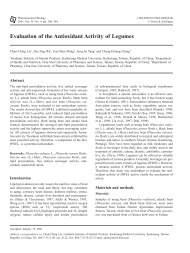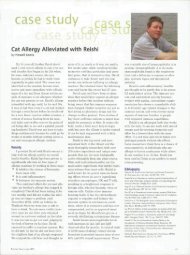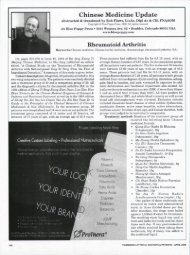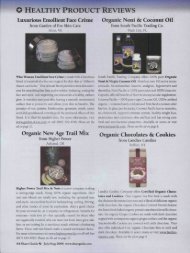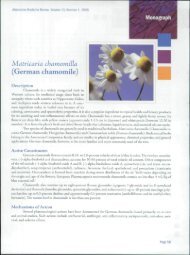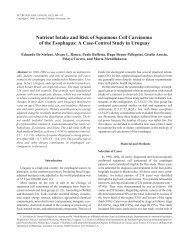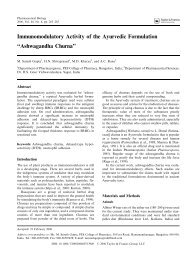Urtica dioica; Urtica urens (Nettle) - Encognitive.com
Urtica dioica; Urtica urens (Nettle) - Encognitive.com
Urtica dioica; Urtica urens (Nettle) - Encognitive.com
Create successful ePaper yourself
Turn your PDF publications into a flip-book with our unique Google optimized e-Paper software.
Alternative Medicine Review Voiume 12, Number 3 2007<br />
<strong>Urtica</strong> <strong>dioica</strong>;<br />
<strong>Urtica</strong> <strong>urens</strong> (<strong>Nettle</strong>)<br />
Description<br />
<strong>Urtica</strong> dioiai (sringing nettle) and <strong>Urtica</strong> <strong>urens</strong> (dwarf<br />
nettle) are members of the Uiticaceae family native to Eurasia,<br />
and arc considered therapcutically interchangeable.^ The term<br />
nettle is used in this article to refer simultaneously to stinging<br />
and dwarf nettle.<br />
<strong>Urtica</strong> prefers wet, rich soil and tends to grow in large<br />
patches. Stinging nettle is taller than dwarf nettle and is perennial;<br />
dwarf nettle is an annual. Both plants have Beshy, drooping,<br />
serrated, roughly heart-shaped leaves. The leaves and stems are covered with stinging hairs (dwarf nettle leaves are<br />
smooth and more delicate). Both produce inconspicuous green-white flowers in late spring or summer. Tlie leaf, flower,<br />
seed, and root of nettle are used differently and contain different chemical constituents.<br />
Constituents and Mechanisms of Actions<br />
Like all green vegetables, nettle leaf is a micronutrient dense, nutritious food; however, it should be steamed or<br />
cooked before ingestion to destroy the stinging hairs, which contain histamine, formic acid, acetylcholine, acetic acid,<br />
butyric acid, leukotrienes, 5-hydroxytryptamine, and other irritants.^' Contact with the hairs leads to a mildly painful<br />
sting, dcvclopnienr of an erythcmatous macule, and irching or numbness for a period lasting from minutes to days.<br />
Medicinal extracts of nettle do not cause this reaction as the Iiairs are destroyed in processing.<br />
The hydrophilic <strong>com</strong>ponents of nettle, including lectins and polysaccharides, appear to be important, particularly<br />
in prostate disease;^ however, hydrophobic constituents have not been ruled entirely unimportant.'' Each constituent<br />
may have individual effects, with the <strong>com</strong>bination acting differently than any one constituent in isolation.<br />
The importance of nettle root Hgnans, such as (-)-3,4-divanillyltetrahydrofuran, in benign prostatic hyperplasia<br />
(BPH) and other androgen- and estrogen-sensitive conditions may be due to interference with binding of sex<br />
hormone binding globulin (SHBG) to testosterone, the testosterone receptor, and/or the SHBG receptor.*"' <strong>Nettle</strong><br />
lectins and sterols did not show anti-SHBG effects in these studies.<br />
Tbe steroidal <strong>com</strong>pounds stigmasterol, stimast-4-en-3-one, and campesterol have been shown to inhibit the<br />
prostatic sodium/potassium pump, which might contribute to nettles effects in BPH.^ The small quantity of betasitosterol<br />
in nettle root (
Testosterone, its metabolite dihydrotestosterone<br />
(DHT), and estrogen are hormones <strong>com</strong>monly associated<br />
with prostate disease. Testosterone is converted<br />
to estrogen via rhe enzyme aromatase. Aromatase levels<br />
increase as men age, testosterone levels decline (as higher<br />
aromatase levels convert testosterone to estrogen),<br />
and the prostate gland be<strong>com</strong>es enlarged. Aromatase<br />
inhibitors are used in BPH to prevent the age-related<br />
rise in estrogen and associated prostate enlargement.<br />
9-hydroxy-10-trans-12-cis-octadecadienic acid (HOA)<br />
from nettle root inhibits aromatase in prostate tissue.'^<br />
A botanical formula consisting of whole herb <strong>Urtica</strong><br />
<strong>dioica</strong> and Pygettm africanum bark was found to inhibit<br />
boch aromatase and 5-alpha reductase.^'' Inhibition of<br />
5-alpha reductase interferes with conversion of testosterone<br />
to DHT, high levels of which are associated with<br />
BPH and prostate cancer.<br />
Polysaccharides and cafFeic malic acid (CMA)<br />
are both found to some extent in ail parts of nettle. Polysaccharides<br />
stimulated T-lymphocyte activity and <strong>com</strong>plement<br />
activation in vitro.^ <strong>Urtica</strong> polysaccharides and<br />
CMA demonstrated anti-inflammatory activity in vitro<br />
and in animal studies, via cyclooxygenase and lipoxygenase<br />
inhibition.-'^ Isolated polysaccharides promoted<br />
tumor necrosis factor (TNF) production in vitro, while<br />
whole plant extracts inhibitedTNF.^'^<br />
Clinical Indications<br />
Benign Prostatic Hyperplasia<br />
The best-researched indication for nettle is<br />
use of the root for men with symptomatic BPH, something<br />
nettle is not known for traditionally. At least four<br />
double-blind clinical trials confirm the efficacy of nettle<br />
root tor BPH symptoms alone or in <strong>com</strong>bination. Earlier<br />
research on a <strong>com</strong>bination with Pygeum extract at<br />
two dose levels, a <strong>com</strong>bination with alpha-adrenergic<br />
antagonists, and a <strong>com</strong>bination with Serenoa repens<br />
(saw palmetto) fruit extracts all show the benefits of<br />
nettle root.'''' In perhaps the most persuasive trial, a<br />
<strong>com</strong>bination of nettle and saw palmetto was just as effective<br />
as finasteride (Proscar") in improving symptoms<br />
of BPH in a 48-week, double-blind trial, with fewer and<br />
milder adverse effects in the herbal group than the drug<br />
group."" Uncontrolled trials have also demonstrated<br />
nettle's effectiveness for<br />
Page 281<br />
Alternative Medicine Review Volume 12, Number 3 2007<br />
Several other randomized, double-blind, placebo-controlled<br />
clinical trials have investigated the effect<br />
of <strong>Urtica</strong> <strong>dioica</strong> (UD) root extracts on lower urinary tract<br />
symptoms (LUTS) associated with BPH. In the largest<br />
study, 558 symptomatic subjects (ages 55-72) received<br />
either 120 mg aqueous extract of UD root (n=287) or<br />
placebo (n=271) three times daily for six months.'" After<br />
six months subjects were evaluated, crossed over to<br />
the alternate group, and the trial continued for another<br />
18 months. Eighty-one percent (n=232) of the treatment<br />
group reported improved LUTS <strong>com</strong>pared to 16<br />
percent (n=43) in the placebo group. Subjects in the<br />
treatment group also exhibited decreased International<br />
Prostate Symptom Score (IPSS) (from 19.8 at baseline<br />
to 11.8 at six months, <strong>com</strong>pared to a decline from<br />
19.2 to 17.7 for placebo). After six months, improvements<br />
in peak flow rate (Qmax) of 8.2 mL in the UD<br />
group, <strong>com</strong>pared to 3.4 mL tor placebo, and significant<br />
decreases in postvoid residual volume (PRV) <strong>com</strong>pared<br />
to placebo were also noted. No significant differences<br />
were observed between groups for PSA or testosterone<br />
levels, but those in the treatment group experienced a<br />
moderate decrease in prostate size. AU improvements<br />
were maintained at the 18-month follow up.~^<br />
In a group of 226 patients, researchers investigated<br />
the efficacy of 459 mg dry UD root extract<br />
(n=114) or placebo (n-112) for one year. Decreases in<br />
IPSS reached statistical significance in the UD group<br />
(18.5±3.0 to 13.8±0.5) <strong>com</strong>pared to placebo, without<br />
significant differences in Qmax or PRV. Subjects in the<br />
treatment group experienced fewer adverse events than<br />
the placebo group.^^<br />
Clinical trials have also examined the effects<br />
of UD in <strong>com</strong>bination with Sabal serrulata fbr relieving<br />
LUTS in patients with BPH. In a multicenter, doubleblind,<br />
placebo-controlled trial, 253 men were assigned to<br />
treatment (n = 127) with 160 mg Sabal fruit extract and<br />
120 mg UD root or placebo (n=126). After a two-week<br />
run-in phase, subjects were randomized to double-blind<br />
treatment for 24 weeks and then to an open control period<br />
of 24 weeks with all study subjects receiving the<br />
herbal extract. At 24 weeks, patients in the treatment<br />
group experienced a significantly greater reduction in<br />
IPSS scores (decrease of six points) <strong>com</strong>pared to the<br />
placebo group (decrease of four points), reflecting improvement<br />
in both obstructive and irritative symptoms.
Alternative Medicine Review Volume 12, Number 3 2007<br />
Subjects switched from placebo to herbal treatment<br />
also reported a marked improvement in LUTS (as measured<br />
by IPSS). The <strong>com</strong>bination extract formula was<br />
well tolerated.-'<br />
Subsequently, this same <strong>com</strong>bination formula<br />
was <strong>com</strong>pared to tamsulosin, an alphal-adrenoceptor<br />
antagonist used to treat LUTS. Subjects (n-140) with<br />
BPH and IPSS scores >13 were randomized to receive<br />
either two capsules (240 mg) herbal extract or 0.4 mg<br />
tamsulosin daily for 60 weeks. IPSS scores were evaluated<br />
at baseline, 8, 16, 24, 36, 48, and 60 weeks. Over<br />
the 60-week period the IPSS scores were reduced by a<br />
median of nine points in both groups; 32.4 percent in<br />
the botanical group and 27.9 percent in the tamsulosin<br />
group responded to treatment. The authors concluded<br />
both treatments were effective (the herbal preparation<br />
slightly more effective), and both were well tolerated<br />
with almost no side effects.^''<br />
Other Urinary Tract Conditions<br />
The German Commission E approves the use<br />
of nettle leaf as supportive therapy in patients with lower<br />
urinary tract infections (<strong>com</strong>bined with immune and<br />
antimicrobial therapy) and to prevent and treat formation<br />
of urinary gravel.'<br />
Arthritis, Neuralgia, and Related<br />
Conditions<br />
Topical application of fresh nettle leaves has a<br />
long history as a counter-irritant for patients with various<br />
pain syndromes. Weiss mentions using topical nettle<br />
for lumbalgia, sciatica, chronic tendonitis, sprains,<br />
and osteoarthritis.^'' Tliis approach is safe if individuals<br />
are not allergic to nettle.<br />
Two case studies suggest topically applied<br />
<strong>Urtica</strong> reduces osteoarthritis pain.^*" In a double-blind<br />
study, topical applications of <strong>Urtica</strong> and Lamiitm album<br />
(white nettle; a plant that has evolved to look like nettle<br />
but does not have stinging hairs) were <strong>com</strong>pared."^ Only<br />
<strong>Urtica</strong> was associated with relief of arthritic symptoms.<br />
Oral dosing of nettle leaf preparations has also<br />
been investigated tor rheumatic conditions. In one open<br />
trial, a leaf extract was associated with symptom reducrion<br />
<strong>com</strong>parable to that achieved with non-steroidal<br />
anti-inflammatory drugs (NSAIDs).^'' In another open<br />
study, nettle leaf (50 g of stewed leaves daily with food)<br />
was shown to potentiate the efficacy of sub-therapeutic<br />
doses ofthe NSAID diclofenac.^"<br />
Cardiovascular Disease<br />
Animal studies indicate UD extracts markedly<br />
inhibit platelet aggregation and improve lipid<br />
profiles,^''- An aqueous extract of UD leaves given to<br />
rats at 1 mg/kg body weight inhibited thrombin-induced<br />
platelet aggregation by 17.1±4.2 percent, while an ethyl<br />
acetate extract inhibited thrombin-induced platelet aggregation<br />
by 76.8±6.1 percent. Flavonoids appear to be<br />
the constituent responsible for this potent inhibition."<br />
Aqueous extracts of 150 mg/kg UD daily given with a<br />
high-fiit diet for 30 days improved lipid profiles in rats.<br />
Significant decreases were noted in total and LDL cholesterol,<br />
plasma Apo B, and the LDL/HDL ratio. Liver<br />
function was assessed and no liver damage was noted.'^<br />
Allergic Rhinitis<br />
Anti-inflammatory effects of nettle leaf suggest<br />
it may be useful for allergic diseases of all types. An<br />
open trial ot 69 patients with allergic rhinitis found 600<br />
mg freeze dried nettle leaf dally was effective for symptom<br />
relief. Fifty-eight percent reported relief of most<br />
symptoms and 48 percent stated it was more effective<br />
than other over-the-counter medications." More rigorous<br />
trials are needed to confirm this finding.<br />
Other Traditional Uses<br />
Nettie leaf has traditionally been used for numerous<br />
other conditions, although confirmatory clinical<br />
trials have not been conducted. Gout, hair loss, and<br />
mild bleeding (particularly mild menorrhagia), are some<br />
ofthe traditional indications tor nettle leiif.'"*<br />
Side Effects and Toxfcity<br />
Internal use of nettle is not associated with any<br />
significant adverse effects. Fiesh nettle causes stings and<br />
can rarely lead to severe allergic reactions in susceptible<br />
individuals.<br />
Page 282
Dosage<br />
Typical daily dosages of <strong>Urtica</strong> (used in studies<br />
cited above) include 360 mg aqueous extract, 460<br />
mg dried extract, and 600 mg freeze-dried nettle. One<br />
study used 50 g stewed nettle leaf daily for rheumatic<br />
conditions. Some nettle root products are standardized<br />
to their scopoletin content, but since this substance is<br />
not established as an active ingredient, the significance<br />
of this standardization is unclear.<br />
Dosages for other nettle preparations include<br />
1 tablespoon nettle juice (15 mL) in 4-6 oz water three<br />
times daily. Steamed (for 10-15 minutes) leaves can be<br />
eaten or added to soup. Vinegar or lemon improves flavor<br />
and may improve absorption of minerals. Tincture<br />
of the leaf or root is taken at a dose of 1/2-1 tsp (2-5<br />
mL) three times daily, or as part ofa formula with other<br />
herbs. <strong>Nettle</strong> leaf tea can be made by steeping 2-3 tsp<br />
herb in 1 pint of boiled water for 10-15 minutes.<br />
References<br />
1. Blumenthal M, Busse WR, Goldberg A, et al, eds.<br />
TIJC Complete German Commission E Monographs:<br />
Therapeutic Guide to Herbal Medicines. Austin, TX:<br />
American Botanical Council; 1998:216.<br />
2. Wagner H, Wilier F, Samtlebcn R, Boos G. Search<br />
for the antiprostatic principle of stinging nettle<br />
{<strong>Urtica</strong> <strong>dioica</strong>) roots. Phytomcdicine 1994;l:213-224.<br />
3. Emmelin N, Fcldherg W. Distribution of<br />
acetylcholine and histaminc in nettle plants. New<br />
Pbytol \949AS:143'\4S.<br />
4. Collier HO, Chesher GB. Identification of<br />
5-hyiiroxytryptamine in the sting of the nettle {<strong>Urtica</strong><br />
<strong>dioica</strong>). HrJ Pharmacol Chemotber 1956;11:186-189.<br />
5. Hitano T, Homma M, Oka K. Effects of stinging<br />
nertle root extracts and their stcroidal <strong>com</strong>ponents<br />
on the Na+,K( + )-ATPascof the benign prostatic<br />
hyperpiasia. Pianta Med 1994;60:30-33.<br />
6. Schottner M, Gansser D, Spiteller G. Lignans fi-om<br />
the roots of <strong>Urtica</strong> <strong>dioica</strong> and their metabolites bind<br />
to human sex hormone binding globulin (SHBG).<br />
Pianta Med 1997:63:529-532.<br />
7. Hryb DJ, Khan MS, Romas NA, Rosner W. The<br />
effect of extracts of the roots of the stinging nettle<br />
[Vrtica <strong>dioica</strong>) on the interaction of SHBG with its<br />
receptor on human prostatic membranes. P/u«Ifl Med<br />
1995:61:31-32.<br />
8. Bcrges RR, Windeler J, Trampisch HJ, Senge T.<br />
Randomised, placebo-controlled, double-blind<br />
clinical trial of bera-sitosterol in patients wich benign<br />
prostatic hyperplasia. Beta-sitosterol Study Group.<br />
Lancet 1995;345:1529-1532.<br />
Page 283<br />
Altemative iVIedicine Review Voiume 12, Number 3 2007<br />
9. Galelli A, Truffa-Bachi P. <strong>Urtica</strong> <strong>dioica</strong> a^lutinin. A<br />
superantigenic lectin from .stinging nettle rhizome. J<br />
im>H(oioM993;151:1821-1831.<br />
10. Muserte P, Galelli A, Chabre H, et al. <strong>Urtica</strong> <strong>dioica</strong><br />
agglutinin, a V beta 8.3-specific superantigen,<br />
prevents rhe development of the systemic lupus<br />
eryrhemacosus'like pathology of MRL lpr/lpr mice.<br />
11. BalzariniJ, Neyts J, Schols D, et al. The mannosespecific<br />
plant lectins from Cymbidium hybrid and<br />
Epipactis bcllcbortne and the (N-acetylgkicosamine)<br />
n-specific plant lectin from <strong>Urtica</strong> <strong>dioica</strong> are porent<br />
and selective inhibitors of human immunodeficiency<br />
virus and cytcmegalovirus repiication in vitro.<br />
Antiviral Res 1992;IS:191-2O7.<br />
12. Wagner H, Geigcr WN, Boos G, Samtleben R.<br />
Studies on the binding of <strong>Urtica</strong> <strong>dioica</strong> agglutinin<br />
(UDA) and other lectins in an in vitro epidermal<br />
growth faiTtoi" receptor test. Phytomedicirie<br />
1995:2:287-290.<br />
13. Kraus R, SpiteUeer G, Bartsch W. (10-E, 12Z)-9hydroxy-10,12-octadecadienic<br />
acid, an aromataseinhibiring<br />
substance from the root extract of <strong>Urtica</strong><br />
<strong>dioica</strong>. Licbigs Ann Chem 1991:19:335-339. [Article<br />
in Gennan]<br />
14. Hartman RW, Mark M, Soldaci F. Inhibition of<br />
5-alpha reduccasc and aromacase by PHL-00801<br />
(Proscaconin), a <strong>com</strong>bination of PY 102 {Pygeum<br />
africanum) and UR 102 {<strong>Urtica</strong> <strong>dioica</strong>) extracts.<br />
Phytomedicine 1996:3:121-128.<br />
15. Obercrels B, Giller K, Teucher T, et al. Antiinflammatory<br />
eftcct of <strong>Urtica</strong> <strong>dioica</strong> folia extract in<br />
<strong>com</strong>parison co caffeic malic ai:id. Arzneimittelforscbung<br />
1996:46:52-56. [Article in German]<br />
16. Obertreis B, Rutckowski T, Teucher T, et al. Ex-vivo<br />
in-vitro inhihicion of lipopolysaccharide stimulated<br />
cumot necrosis faccor-alpha and interIeukin-1 beta<br />
secretion in human whole blood hy extractiim <strong>Urtica</strong>e<br />
<strong>dioica</strong>e foliorum. Arzneimittelforschung 1996:46:389-<br />
394.<br />
17. Krzeski T, Kazon M, Borkowski A, et al. Combined<br />
extracts of <strong>Urtica</strong> diotca and Pygeum africanum<br />
in che treatment of benign proscacic hyperplasia:<br />
donble-blind <strong>com</strong>parison of cwo doses. Clin Iher<br />
1993:15:1011-1020.<br />
18. Neumann HG, Combination therapy ot henigii<br />
proscacic hyperplasia (BPH) with phytotherapy and<br />
selective alpha 1-blockade. Urologe B 1993;33:384-<br />
385. [Article in German]<br />
19. Voncobel HP, Hcrzog R, Rutishauser G, Kres H.<br />
Results ofa double-blind sciidy on tlie effectiveness<br />
of ERU (excractum radicis Urcicae) capsules<br />
in conservacive treacmenc of benign prostacic<br />
hyperplasia. Urologe A 1985;24:49-51. [Article in<br />
German]
Alternative Medicine Review Volume 12, Number 3 2007<br />
20. Sokeland J, AlbrechtJ. Combination of Sabal and 26.<br />
<strong>Urtica</strong> extract vs. finasteride in benign prostatic<br />
hyperpLisia (Aiken stages I to II). Comparison ot 27.<br />
therapeutic effectiveness in a one year double-blind<br />
study. Urologc A 1997:36:327-333. [Article in 28.<br />
German J<br />
21. Beiaiche P, Lievoux O. Clinical studies on the<br />
palliative treatment of prostatic adenoma with extract 29.<br />
of <strong>Urtica</strong> root. Phytothcr Ra 1991:5:267-269.<br />
22. Safarinejad MR. <strong>Urtica</strong> <strong>dioica</strong> for treatment of benign<br />
prostatic hyperplasia: prospective, randomized,<br />
double-blind, placebo-controlled, crossover study.J 30.<br />
Herb Phartnacothcr 200S;5:\-n.<br />
23. Schneider T, Rubben H. Stinging nettle root extract<br />
(Bazoton-uno) in long term treatment of benign<br />
prostatic syndrome (BPS). Results of a tandomizcd, 31.<br />
double-blind, placebo controlled niulticenter study<br />
after 12 months. Urologe A 2004:43:302-306. [Article<br />
in German] 32.<br />
24. Lopatkin N, Sivkov A, Walther C, et al. Long-term<br />
efficacy and safety of a <strong>com</strong>bination of Sabal and<br />
<strong>Urtica</strong> extract tor lower urinary tract symptoms - a 33.<br />
placebo-controlled, double-blind, multicenter trial.<br />
World J Uro/2005:23:139-146.<br />
25. Engelmann U, Walther C, Bondarenko B, et al. 34.<br />
Efficacy and safety of a <strong>com</strong>bination of Sabal and<br />
<strong>Urtica</strong> extract in lower urinary tract symptoms. A<br />
randomized, double-blind study versus tamsulosin.<br />
Arzneimittcljorschung 2006;56:222'229.<br />
Weiss RF. Herbal Medicine, 6th ed. Beaconsfield,<br />
England: Beacon.sfield Publishers Ltd; 1988:261-262.<br />
Randall CR Stinging nettles for osteoarthritis pain of<br />
the hip. Brj Gen Pract 1994:44:533-534.<br />
Randall C. Randall H. Dobbs F, et ai. Randomized<br />
controlled trial of nettle sring tor treatment of baseof-thumb<br />
pain.J R Soc Mcd 2000;93:305-309.<br />
Sommer RG, Sinner B. IDS 23 in the therapy of<br />
rheumatic disease. Do you know the new cytokine<br />
antagonistsf Therapiewoche 1996;46:44-49. (Article<br />
in German]<br />
Chrubasik S, Enderlein W, Bauer R, Grabner W.<br />
Evidence for the antirhcumatic effectiveness of<br />
herbal <strong>Urtica</strong>c <strong>dioica</strong>c in acute .irthritis: a pilot study.<br />
Phytomedicnw 1997 A-AOS'108.<br />
El Haouari M, Bnouham M, Bendaluiu M, et al.<br />
Inhibition of rat platelet aggregation by <strong>Urtica</strong> <strong>dioica</strong><br />
le.ivcs extracts. Phytothcr Res 2006:20:568-572.<br />
Daher CF, Baroody KG, Baroody GM. Eff'ect of<br />
<strong>Urtica</strong> <strong>dioica</strong> extract intake upon blood lipid profile in<br />
the rats. Fitotcrapia 2006:77:183-188.<br />
Mittman P. Randomized, double-blind study of<br />
freeze-dricd Urttca liioiai in the treatment of allergic<br />
rhinitis. P/rfHM Mai 1990:56:44-47.<br />
Grieve M. A Modern Herbal. Vol 2. New York, NY:<br />
Dover Publications:1971:574-579.<br />
Page 284



